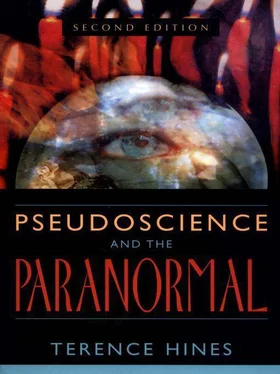Once you know how it’s done, the whole thing seems extremely simple. But almost no one, unless they are familiar with the methods of spiritualists and similar con artists, will figure out on their own what happened. They are much more likely to attribute it to the powers of the spirits and the spiritualists. As a result, they may increase their donation to the spiritualist.
Another favorite spiritualist trick, used when facing large groups, is billet reading. The basic technique is familiar to anyone who has seen Johnny Carson’s “Amazing Carnak” routine. It’s called the “old one ahead” in the trade. The idea is to convince the congregation that the spirits are providing the spiritualist with information that the spiritualist would otherwise be unable to obtain. At the start of the spiritualist service (not a seance but a service similar to those in established churches), the people present are asked to write a question for the spirits on a card and seal it in an envelope. The sealed envelopes are then collected. Later in the service, the spiritualist holds them up one at a time and, without opening them, reads the question, which is presumably being communicated to him by the spirits. At this point, someone in the congregation will usually exclaim that that was his or her question. The spiritualist then answers the question, tears open the envelope to satisfy himself that the spirits communicated the correct question and answer, then picks up the next envelope and continues. Again, it’s a simple trick, once you know how.
Before the “reading” starts, the spiritualist opens one of the envelopes and memorizes that question. There are several ways of finding out what is in one envelope, even if the envelopes are in full view of the audience at all times (see Corinda 1968, for a detailed discussion of these techniques as used by legitimate stage magicians). Once the spiritualist has memorized the first question, the rest is easy. The spiritualist picks what the audience thinks is the first envelope (it’s really a second envelope), holds it up, recites from memory the first question, answers it, then rips open the envelope he’s holding. The audience thinks the spiritualist is simply verifying that the envelope really contained the question he just obtained from the spirits. In fact, the spiritualist has just opened the second envelope and is reading a second question. He then picks up a third envelope (the audience thinks it’s the second) and reads off the question that was in the previous envelope. A simple trick, but very effective if done well.
In addition to the use of stage magic techniques, spiritualists and psychics use other, more mundane techniques to convince their victims that they have extraordinary powers. For example, most spiritualists and psychics don’t just see anyone who walks in off the street; instead, new clients must make an appointment. This allows time for the accumulation of information. One way of obtaining information about a new client is through a private detective. A detective is especially likely to be used when the victim is wealthy enough to justify the expense involved. However, a great deal of information about an individual can be obtained through other, less expensive sources. For example, in many states, one’s driving record and driver’s license abstract are public information, available for a fee of a few dollars. These records may contain information on age, exact birth date, accident record, insurance company, driver’s license and policy number, and so forth. The individual’s address gives information about the neighborhood he lives in and, hence, his income level, ethnic background, and perhaps religious background. A slow drive past the house will reveal much—the type of house, the color, the number and type of cars in the driveway, the presence of children’s toys on the lawn. All this information, available essentially for free, can be fed back to the victim, who will likely be amazed that the psychic could know such details about his or her life. The victim will almost always accept the psychic’s knowledge of this information as proof of his or her powers.
Modern spiritualists and psychics keep detailed files on their victims. As might be expected, these files can be very valuable and are often passed on from one medium or psychic to another when one retires or dies.
Even if a psychic doesn’t use a private detective or have immediate access to driver’s license records and such, there is still a very powerful technique that will allow the psychic to convince people that the psychic knows all about them, their problems, and their deep personal secrets, fears, and desires. The technique is called cold reading and is probably as old as charlatanism itself. The technique has been described in detail by Hyman (1976–77).
In a cold reading, the reader begins with a “stock spiel,” a set of general statements that will apply to almost everyone. Because the majority of human problems fall into one of three general categories—sex, money, or health—the reader already has some idea of the nature of the victim’s problem. Of course, the nature of the problem can, to some extent, be predicted by carefully observing the age, mode of speech, style of dress, and physical appearance of the victim. If the victim is young, health problems are not likely to be the reason for the consultation. Sex or personal problems are much more likely to be the reason for the visit. If the victim is a college student—this can be ascertained by simply asking during pre-reading chitchat, another extremely valuable source of information, or by noting a college ring or fraternity pin-concern about grades is also a strong possibility. In any case, information obtained by careful observation of the victim is then used to guide the reading toward the most likely problem area. For example, if a woman comes in wearing an expensive dress and lots of jewelry, money is probably not the problem she’s come to talk about. Elderly people are more likely to have health problems, and many of these can be spotted simply by looking at the victim—the tremors of Parkinson’s disease, the hobbling caused by arthritis, and the types of paralysis caused by some strokes can all be readily observed.
As an exercise, put yourself in the position of a cold reader and see what you make of this: A middle-aged man, good looking and well dressed, walks in. During idle chat before the reading, you discover he’s in town for a week or so on business. You also note that there is a white area of skin at the base of his ring finger. What do you conclude?
Students often answer that the fellow has been recently divorced and thus no longer wears a wedding ring. A logical response, and perhaps right, but there is another, somewhat seamier, possibility: Perhaps the man is playing around while he’s away from his wife and that’s why he’s not wearing his ring. How do you tell which alternative is true, or whether neither is true? (After all, his wife could have died recently.) Finding out is simple—you ask, but in such a way that he’s not aware you’re asking and isn’t aware he’s given you the information. You then, later in the reading, feed the information he’s given you back to him, and he’s probably amazed at your psychic powers.
One of the most powerful sources of information for a cold reader is vague statements in the form of leading questions. For example, you could say something like, “I see a recent loss in your life,” and inflect the end of the sentence like a question. Because of the inflection, the victim will almost always respond as to a question. He may answer right out, “Yes, my wife just died,” or “My wife and I were separated last month.” Or the response may be more subtle and almost unconscious—a nod of the head, for example. Even such subtle responses confirm that you’re on the right track. If you get a puzzled look and a shake of the head, you know you’re on the wrong track. He hasn’t suffered a recent loss, so the “fooling around” hypothesis is more likely. At this point, don’t come out and say, “I see you cheating on your wife.” Never make a specific statement like that in a cold reading. For one thing, it may get you a fist in your face. For another, it may start the victim wondering how you obtained such specific information, and he may be able to figure it out for himself. Instead, make it a bit vague: “The spirits point to less than total satisfaction with the woman in your life.” Note that you don’t say “your wife” here. By being vague, you’re protecting yourself: You may be wrong after all. Maybe his wife did just die. How embarrassing it would be for you to say “your wife” and use the present tense.
Читать дальше












